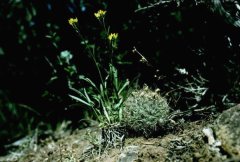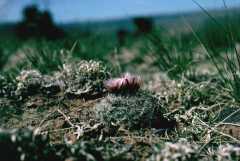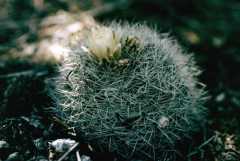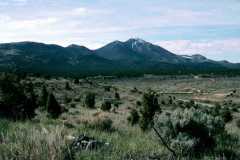Pediocactus simpsonii
(Engelmann)Britton&Rose 1913
Moon-flower ball(Japanese name)
Pediocactus simpsonii looks like a Mammillaria species but its flower blooms near the apex. That is a impression of P.simpsonii for
many cactus lover. However, particular feature of this species is that
they are adapted to the cold environment of high altitude. P.simsonii is
distributed almost all over states of western US, from high mountain of
New Mexico and Arizona in southern part, near Canadian border of Washington
and Montana in northern part. The area is really vast. And also they extend
their habitat from Sagebrush Desert into high mountain forest of Rocky
over 3000m. They endure -10 to -25c or lower in winter sometimes covered
with snow. The place they live is not always 'desert' we think cactus country
should be. We can find them in deep forest, high trees of oak or pine where
we can not walk around without compass! Therefore the environmental factors
of such a kind of habitat are the points to be specially considered in
cultivation. They have a feature of 'alpine plant' in one aspect.
Because they live in various environments on vast area, the range of variation
is also very large. Plant body, size, spination, flower color are variable.
In some locality plants grow thick and large like 'spiny bascket ball'.
On the other hand small 'mimicry type' plant is almost buried in the ground.
About this species, there are some different views of classfication still
now among researchers. The general opinion is that the basic species includes
some subspecies. Or some ssp is regarded as independent species by some
expert. In horticulture, what is necessary may be just to enjoy various
'faces' from many localities, and collecting the plants with 'field number'.
An example of a classification is below;
Pediocactus simpsonii ssp. simpsonii
Basic species. growing to 15cm at the maximum, but in some locality only
several centimeters.
Plants are distributed from Montana, Idaho, Wyoming, Colorado, Utah, Nevada, New Mexico, Arizona. They are adapted not only forest-environmen but also Prairie-environment.
A certain type from Idaho is called ssp.indraianus.
Pediocactus simpsonii ssp. minor.
The difference from basic species is not clear. Plants have more small
body and delicate spine.. Distribution area is higher altitude than basic
species, in Wyoming, Colorado, New Mexico.
Pediocactus simpsonii ssp. nigrispinus
Plants with larger-sized body than basic species, often make a large clump.
They are armed with the strong and darker colored spines look like Ped.sileri.
They live mostly in volcanic soil of western states, Washington and Oregon.
They have tap roots for adaptation to such a kind of soil.
ssp.puebloensis is from 'alpine tundra' near the altitude 2000m of Oregon
Pediocactus simpsonii ssp. robstior
Plants are similar to ssp.nigrispinus but they are distributed only in
Nevada, 2000m or more in altitude.They don't have tap roots.
I have visited only a few locality still now and this page is also incomplete.
I would like to introduce more pictures from various habitats in near future.
 BACK
BACK
 |
Pedio.simpsonii ssp.minor
(Montezuma Co, Colorado)
This area is fairly heavily forested by pinyon-oak and over 2000m in altitude.
Plants grow in the shade of a tree. They have small spherical (or elongated)
body and sometimes clumped.
|
 |
Pedio.simpsonii ssp.simpsonii
(Wayne CO., Utah)
This place is boundary line between grassland and juniper-pinyon forest.
Plants are exposed to directly full sun and buries most of their body in
the ground. The population density is very high. |
 |
Pedio.simpsonii ssp.simpsonii
(Whitepine Co, Nevada)
Plants with delicate white spine and cream-colored flower are very beautiful. They live under a tall tree of pine. Here is also heavily forested and I nearly lost my way when I was looking for the plants. |
 |
Pedio.simpsonii ssp.simpsonii
(Whitepine Co, Nevada)
This place is about 30 miles west of above mentioned. It was in June I
visited this place but the mountain was still covered with snow.
|
Click thumbnail to see more picture and infomation.




